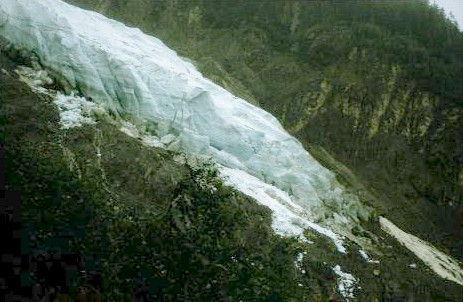Climate Change- Interaction with Glaciers
There is much talk about global warming these days, but scientists know that periods of warming have happened before. Evidence from ice cores has revealed variations in average temperatures around the world going back hundreds of thousands of years. This tells us that natural events can lead to the planet becoming warmer or cooler, but global warming today seems to be a combination of natural and man made causes.
Glaciers, being cold things, are particularly sensitive to small changes in temperature where the average temperature has been around freezing point. A one degree change from 0 to -1 or to +1 degrees can mean the difference between a glacier melting, or growing.
Scientists generally agree that almost all glaciers in Europe have been retreating during the last one hundred years and they expect that the retreat will continue. Some small glaciers have vanished totally, and others have retreated further up mountains, releasing millions of tonnes of fresh water.
The discovery in 1991 of a body that had lain frozen in glacial ice for 5000 years was great for archaeologists, but also significant for geographers. The fact that the body was revealed showed that the snows accumulated over the last 5000 years had melted away to expose the body.
As glaciers melt, they release fresh water. That sounds like a good thing, and it would be if we could send the water to the places that need it. Unfortunately, almost all the water goes into the oceans and that's where the problems start.
An obvious result of more water in the oceans is that sea levels rise. That's not good news for low lying land and for people living on lowland coasts. There are already scientists who believe than many cities will be threatened by flooding in the next 100 years.
Fresh water is different to salt water - it is less dense. That doesn't sound like much of a problem but actually, it could be even more worrying than sea level rises. The world's weather patterns are controlled by ocean currents that move billions of litres of warm water from the equator towards the poles, and cold water from the poles towards the equator. These currents explain why Hudson Bay in Canada freezes solid every winter whilst Scotland February 23, 2006whilst warm equatorial water flows north along the Scottish coast. The bit where fresh water gets involved is at the point where the warm water stops flowing north, cools, sinks and starts flowing back south as cold water.
You probably know that warm water expands and thus becomes less dense - and cold water becomes more dense, and sinks. Now, if you add too much fresh water to the salty sea water, you change it's density, making it less dense and less likely to sink!
If the amount of fresh water became enough to stop the warm water from sinking, the entire ocean current system could stop working. The subsequent changes in climate cannot be calculated, but we do know that the whole planet would experience big changes!
On a much smaller scale, many countries rely on glaciers for water supplies, hydro-electric power production, fresh silt to rejuvenate fields and for tourism. India and Pakistan are worried that shrinking glaciers in the Himalayas will disrupt their water supplies, and in Europe many winter tourism locations are developing plans for when the local glaciers and snow fields retreat further or vanish.
| Red Tarn, in the English Lake District, was the head of a glacier about 10,000 years ago when the entire area was covered in thick ice. Today, only the very top of the Uk's highest mountain retains snow all your round. This shows that average temperatures in the UK have risen in the last 10,000 years. | |
 d d |
This photograph shows the retreating snout of an Alpine glacier in France. The exposed rock areas on either side of the ice show how wide and deep the ice used to be when the glacier was advancing in a cooler climate. It is predicted that such glaciers will continue to retreat during the next century. |
![]()
